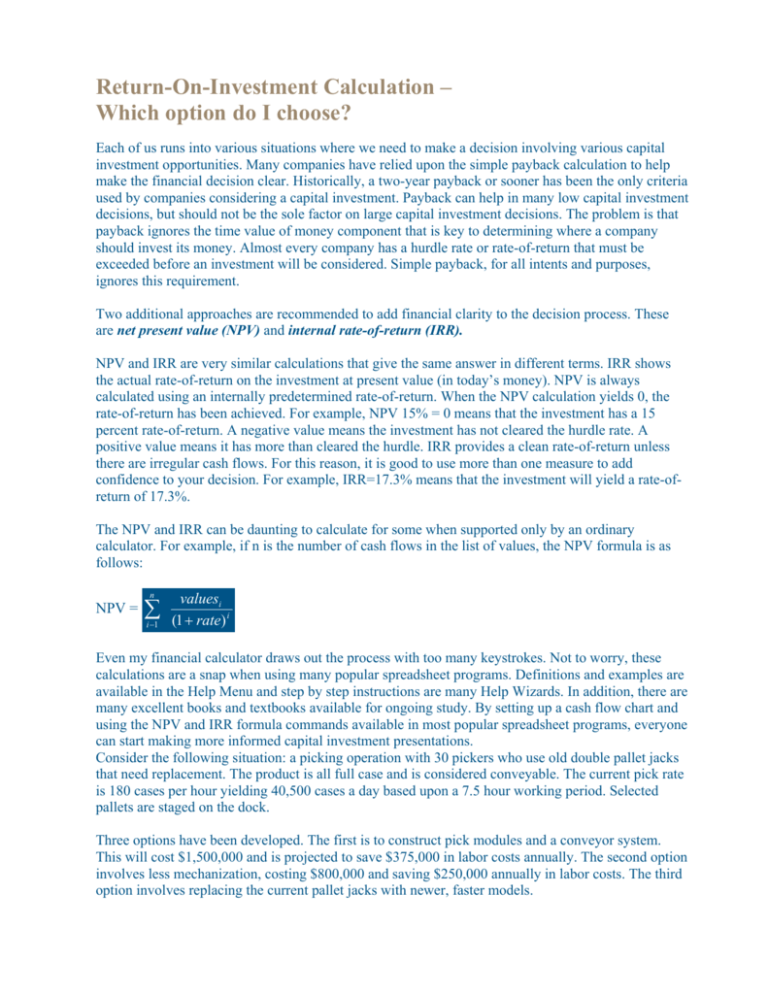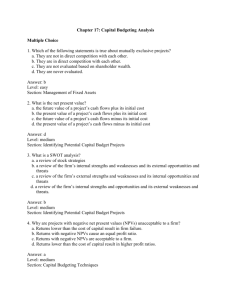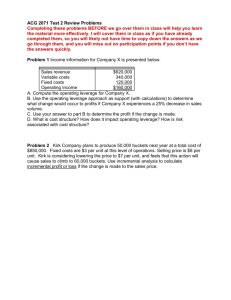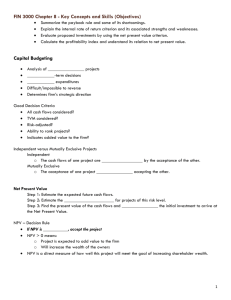
Return-On-Investment Calculation –
Which option do I choose?
Each of us runs into various situations where we need to make a decision involving various capital
investment opportunities. Many companies have relied upon the simple payback calculation to help
make the financial decision clear. Historically, a two-year payback or sooner has been the only criteria
used by companies considering a capital investment. Payback can help in many low capital investment
decisions, but should not be the sole factor on large capital investment decisions. The problem is that
payback ignores the time value of money component that is key to determining where a company
should invest its money. Almost every company has a hurdle rate or rate-of-return that must be
exceeded before an investment will be considered. Simple payback, for all intents and purposes,
ignores this requirement.
Two additional approaches are recommended to add financial clarity to the decision process. These
are net present value (NPV) and internal rate-of-return (IRR).
NPV and IRR are very similar calculations that give the same answer in different terms. IRR shows
the actual rate-of-return on the investment at present value (in today’s money). NPV is always
calculated using an internally predetermined rate-of-return. When the NPV calculation yields 0, the
rate-of-return has been achieved. For example, NPV 15% = 0 means that the investment has a 15
percent rate-of-return. A negative value means the investment has not cleared the hurdle rate. A
positive value means it has more than cleared the hurdle. IRR provides a clean rate-of-return unless
there are irregular cash flows. For this reason, it is good to use more than one measure to add
confidence to your decision. For example, IRR=17.3% means that the investment will yield a rate-ofreturn of 17.3%.
The NPV and IRR can be daunting to calculate for some when supported only by an ordinary
calculator. For example, if n is the number of cash flows in the list of values, the NPV formula is as
follows:
n
NPV =
∑
i −1
valuesi
(1 + rate) i
Even my financial calculator draws out the process with too many keystrokes. Not to worry, these
calculations are a snap when using many popular spreadsheet programs. Definitions and examples are
available in the Help Menu and step by step instructions are many Help Wizards. In addition, there are
many excellent books and textbooks available for ongoing study. By setting up a cash flow chart and
using the NPV and IRR formula commands available in most popular spreadsheet programs, everyone
can start making more informed capital investment presentations.
Consider the following situation: a picking operation with 30 pickers who use old double pallet jacks
that need replacement. The product is all full case and is considered conveyable. The current pick rate
is 180 cases per hour yielding 40,500 cases a day based upon a 7.5 hour working period. Selected
pallets are staged on the dock.
Three options have been developed. The first is to construct pick modules and a conveyor system.
This will cost $1,500,000 and is projected to save $375,000 in labor costs annually. The second option
involves less mechanization, costing $800,000 and saving $250,000 annually in labor costs. The third
option involves replacing the current pallet jacks with newer, faster models.
Assume the hurdle rate is 20 percent. In other words, the company has investment opportunities that
yield at least this amount and will not consider any below this level but will give preference to
investments with the greatest return.
For cell reference purposes, the upper left cell in the charts below is A1. The MS Excel formulas for
NPV and IRR are as follows where B7:G7 is the range of the Total Project Cash flows and 20 percent
is the minimum rate-of-return.
=NPV(20%,B7:G7)
=IRR(B7:G7)
The payback formula is as follows:
=IF(C8>=0,-B8/C7,IF(D8>=0,1+(-C8/D7),IF(E8>=0,2+(-D8/E7),IF(F8>=0,3+(E8/F7),IF(G8>=0,4+(-F8/G7),"5+")))))
The three charts below illustrate the cash flows setup for each option.
Option 1
Year
0
1
2
3
4
5
$ 375,000
$ 375,000
$ 375,000
$ 375,000
Total Projec t Cas hflow $ (1,500,000) $ 375,000 $ 375,000 $ 375,000 $ 375,000
Cum m ulative Cas hflow $ (1,500,000) $ (1,125,000) $ (750,000) $ (375,000) $
-
$ 375,000
$ 375,000
Labor Savings
$
Investm ent $ (1,500,000)
NPV@ 20%
IRR
Payback
375,000
($315,434)
7.9%
4.00
Option 2
Year
0
Labor Savings
Investm ent $
Total Projec t Cas hflow $
Cum m ulative Cas hflow $
NPV@ 20%
IRR
Payback
1
$
2
3
4
5
$ 268,000
$ 268,000
$ 268,000
$ 268,000
268,000 $ 268,000 $ 268,000
(532,000) $ (264,000) $
4,000
$ 268,000
$ 272,000
$ 268,000
$ 540,000
268,000
(800,000)
(800,000) $
(800,000) $
$1,237
20.1%
2.99
Option 3
Year
0
Labor Savings
Investm ent $
Total Projec t Cas hflow $
Cum m ulative Cas hflow $
NPV@ 20%
IRR
Payback
1
$
2
3
4
5
$ 112,500
$ 112,500
$ 112,500
$ 112,500
112,500 $ 112,500 $ 112,500 $ 112,500
(287,500) $ (175,000) $ (62,500) $ 50,000
$ 112,500
$ 162,500
112,500
(400,000)
(400,000) $
(400,000) $
($52,963)
12.6%
3.56
In all of the examples above, the typical two year payback is not achieved. Had this been the only
evaluation criterion, most likely the project would not get funded. However, using the time value of
money and the company’s 20 percent hurdle rate, we find that Option 2 has financial merit.
Option 1 has a negative NPV with an IRR of only 7.9 percent and a payback of four years. This
obviously has not cleared the minimum rate-of-return and should not be presented.
Option 2 meets the hurdle rate showing a positive NPV and 20.1 percent IRR with a three-year
payback. This option is worthy of consideration and should be presented to management.
Option 3 has a negative NPV with an IRR of 12.6 percent and a payback of 3.5 years. Unless there is
some compelling non-financial reason, this option should not be considered. It is the least expensive
option, but not the best in terms of return-on-investment.
All things being equal, Option 2 is the better financial investment.
We all know that other factors need to be brought into the decision-making process like risk, available
capital, other investment opportunities, business disruption, senior management’s thoughts, etc.
Hopefully this will get you started on the path to taking your opportunity presentations to the next
level. More and more, the Chief Financial Officer is getting involved earlier in the capital expenditure
approval process. The more we can speak and convey our thoughts and ideas in that language, the
more successful we’ll be in both presenting solid ideas and getting those ideas approved.
Tom Zosel Associates (TZA) is the world leader in optimizing logistics
performance. Consistently delivering results for numerous logistics
leaders, TZA helps clients reduce operating costs, substantially improve
logistics processes, eliminate bottlenecks, increase throughput and
capacity, achieve material handling automation goals, and optimize total
logistics network performance.
3880 RFD Salem Lake Drive
Long Grove, IL 60047
847-540-6543
fax: 847-540-9988
www.tzaconsulting.com
Copyright, TZA Associates. All rights reserved.
These results are achieved through a focused portfolio of consulting
services and technology tools. TZA’s unique methodology, which helps
companies improve strategic decisions through an unbiased,
comprehensive evaluation of appropriate alternatives, enables companies
to achieve their logistics goals at the minimum level of required
investment.
TZA’s core competencies include Strategic Network Design, Facility
Design and Material Handling Engineering, Transportation System
Design, Logistics Software Solutions and Productivity Improvement
Programs. TZA’s ProTrack software offers the industry’s most powerful
labor planning and reporting software solution.










